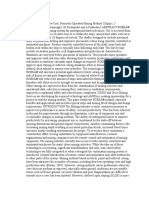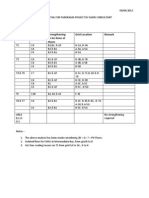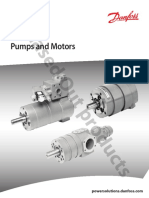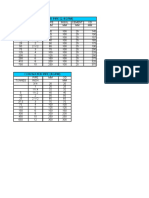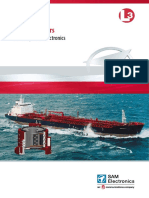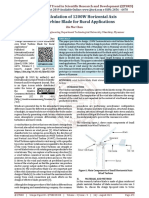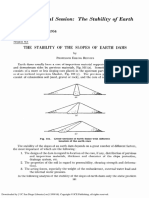0 ratings0% found this document useful (0 votes)
798 viewsAngle of Repose
Angle of Repose
Uploaded by
vinmanishsThis article discusses the angle of repose, which is the steepest angle at which a granular material can pile without slumping. It ranges from 20-50 degrees depending on factors like the material's shape, size, and moisture content. The angle of repose is important in designing equipment to store and transport materials and in determining slope stability. It is also exploited by antlion larvae, which use it to construct pitfall traps that capture prey.
Copyright:
© All Rights Reserved
Available Formats
Download as DOC, PDF, TXT or read online from Scribd
Angle of Repose
Angle of Repose
Uploaded by
vinmanishs0 ratings0% found this document useful (0 votes)
798 views6 pagesThis article discusses the angle of repose, which is the steepest angle at which a granular material can pile without slumping. It ranges from 20-50 degrees depending on factors like the material's shape, size, and moisture content. The angle of repose is important in designing equipment to store and transport materials and in determining slope stability. It is also exploited by antlion larvae, which use it to construct pitfall traps that capture prey.
Original Description:
angle of repose
Copyright
© © All Rights Reserved
Available Formats
DOC, PDF, TXT or read online from Scribd
Share this document
Did you find this document useful?
Is this content inappropriate?
This article discusses the angle of repose, which is the steepest angle at which a granular material can pile without slumping. It ranges from 20-50 degrees depending on factors like the material's shape, size, and moisture content. The angle of repose is important in designing equipment to store and transport materials and in determining slope stability. It is also exploited by antlion larvae, which use it to construct pitfall traps that capture prey.
Copyright:
© All Rights Reserved
Available Formats
Download as DOC, PDF, TXT or read online from Scribd
Download as doc, pdf, or txt
0 ratings0% found this document useful (0 votes)
798 views6 pagesAngle of Repose
Angle of Repose
Uploaded by
vinmanishsThis article discusses the angle of repose, which is the steepest angle at which a granular material can pile without slumping. It ranges from 20-50 degrees depending on factors like the material's shape, size, and moisture content. The angle of repose is important in designing equipment to store and transport materials and in determining slope stability. It is also exploited by antlion larvae, which use it to construct pitfall traps that capture prey.
Copyright:
© All Rights Reserved
Available Formats
Download as DOC, PDF, TXT or read online from Scribd
Download as doc, pdf, or txt
You are on page 1of 6
At a glance
Powered by AI
The angle of repose is the maximum angle at which a granular material can pile without slumping and is dependent on factors like particle size and shape. It is important in designing equipment like silos and determining slope stability.
The angle of repose is the steepest angle of descent or dip at which a material can be piled without slumping. There are several methods to measure it including the tilting box method and fixed funnel method.
The angle of repose is used in designing hoppers, silos, and conveyor belts. It can also be used to determine if a slope will likely collapse and is used by mountaineers to analyze avalanche danger.
This article needs additional citations for verification.
Please help improve
this article by adding citations to reliable sources. Unsourced material may be
challenged and removed. (August 2009)
Angle of repose
The angle of repose or the critical angle of repose,
[1]
of a granular material is the steepest angle
of descent or dip relative to the horizontal plane to hich a material can be piled ithout
slumping. At this angle, the material on the slope face is on the verge of sliding. The angle of
repose can range from !" to #!". $mooth, rounded sand grains cannot be piled as steeply as can
rough, interloc%ing sands. &f a small amount of ater is able to bridge the gaps beteen particles,
electrostatic attraction of the ater to mineral surfaces ill increase soil strength.
'hen bul% granular materials are poured onto a horizontal surface, a conical pile ill form. The
internal angle beteen the surface of the pile and the horizontal surface is %non as the angle of
repose and is related to the density, surface area and shapes of the particles, and the coefficient of
friction of the material. (oever, a )!11 study shos that the angle of repose is also gravity*
dependent.
[)]
+aterial ith a lo angle of repose forms flatter piles than material ith a high
angle of repose.
The term has a related usage in mechanics, here it refers to the ma,imum angle at hich an
ob-ect can rest on an inclined plane ithout sliding don. This angle is e.ual to the arctangent of
the coefficient of static friction
s
beteen the surfaces.
Contents
[hide]
1 Applications of theory
) +easurement
/ 0,ploitation by antlion and ormlion 12ermileonidae3 larvae
4 +ethods in determining the angle of repose
o 4.1 Tilting bo, method
o 4.) 5i,ed funnel method
o 4./ 6evolving cylinder method
7 Angle of repose of various materials
8 $ee also
9 6eferences
Applications of theory[edit]
Talus cones on north shore of &sf-ord,$valbard, :oray, shoing angle of repose for coarse sediment
The angle of repose is sometimes used in the design of e.uipment for the processing of
particulate solids. 5or e,ample, it may be used to design an appropriate hopper or silo to store
the material, or to size a conveyor belt for transporting the material. &t can also be used in
determining hether or not a slope 1of a stoc%pile, or uncompacted gravel ban%, for e,ample3
ill li%ely collapse; the talus slope is derived from angle of repose and represents the steepest
slope a pile of granular material ill ta%e. This angle of repose is also crucial in correctly
calculatingstability in vessels.
&t is also commonly used by mountaineers as a factor in analysing avalanche danger in
mountainous areas.
+easurement[edit]
There are numerous methods for measuring angle of repose and each produces slightly different
results. 6esults are also sensitive to the e,act methodology of the e,perimenter. As a result, data
from different labs are not alays comparable. <ne method is the tria,ial shear test, another is
the direct shear test.
&f the coefficient of static friction is %non of a material, then a good appro,imation of the angle
of repose can be made ith the folloing function. This function is somehat accurate for piles
here individual ob-ects in the pile are minuscule and piled in random order.
[/]
here,
s
is the coefficient of static friction, and is the angle of repose.
0,ploitation by antlion and ormlion 12ermileonidae3 larvae[edit]
$and pit trap of the antlion
The larvae of the antlions and the unrelated ormlions 2ermileonidae trap small insects such
as ants by digging conical pits in loose sand, such that the slope of the alls is effectively at
the critical angle of repose for the sand.
[4]
They achieve this by flinging the loose sand out of
the pit and permitting the sand to settle at its critical angle of repose as it falls bac%. Thus,
hen a small insect, commonly an ant, blunders into the pit, its eight causes the sand to
collapse belo it, draing the victim toard the center here the predator that dug the pit
lies in ait under a thin layer of loose sand. The larva assists this process by vigorously
flic%ing sand out from the center of the pit hen it detects a disturbance. This undermines
the pit alls and causes them to collapse toard the center. The sand that the larva flings
also pelts the prey ith so much loose, rolling material as to prevent it from getting any
foothold on the easier slopes that the initial collapse of the slope has presented. The
combined effect is to bring the prey don to ithin grasp of the larva, hich then can in-ect
venom and digestive fluids.
+ethods in determining the angle of repose[edit]
Tilting box method[edit]
This method is appropriate for fine*grained, non*cohesive materials, ith individual particle
size less than 1! mm. The material is placed ithin a bo, ith a transparent side to observe
the granular test material. &t should initially be level and parallel to the base of the bo,. The
bo, is sloly tilted at a rate of appro,imately !./ degrees=second. Tilting is stopped hen
the material begins to slide in bul%, and the angle of the tilt is measured.
Fixed funnel method[edit]
The material is poured through a funnel to form a cone. The tip of the funnel should be held
close to the groing cone and sloly raised as the pile gros, to minimize the impact of
falling particles. $top pouring the material hen the pile reaches a predetermined height or
the base a predetermined idth. 6ather than attempt to measure the angle of the resulting
cone directly, divide the height by half the idth of the base of the cone. The inverse tangent
of this ratio is the angle of repose.
Revolving cylinder method[edit]
The material is placed ithin a cylinder ith at least one transparent face. The cylinder is
rotated at a fi,ed speed and the observer atches the material moving ithin the rotating
cylinder. The effect is similar to atching clothes tumble over one another in a sloly
rotating clothes dryer. The granular material ill assume a certain angle as it flos ithin
the rotating cylinder. This method is recommended for obtaining the dynamic angle of
repose, and may vary from the static angle of repose measured by other methods. 'hen
describing the angle of repose for a substance, alays specify the method used.
Angle of repose of various materials[edit]
(ere is a list of various materials and their angle of repose.
[7]
All measurements are
appro,imated and not e,act.
Material (condition) Angle of Repose (degrees)
Ashes 40
Asphalt (crushed) 3045
Bark (wood refuse) 45
Bran 3045
Material (condition) Angle of Repose (degrees)
Chalk 45
Clay (dry lump) 2540
Clay (wet eca!ated) "5
Clo!er seed 2#
Coconut (shredded) 45
Coffee $ean (fresh) 3545
%arth 3045
&lour (corn) 3040
&lour (wheat) 45
'ran(te 3540
'ra!el (loose dry) 3045
'ra!el (natural w) sand) 2530
*alt 3045
+and (dry) 34
Material (condition) Angle of Repose (degrees)
+and (water f(lled) "530
+and (wet) 45
+now 3#
,-.
/rea ('ranular) 20
,0.
1heat
20
You might also like
- MM9000 Rev-A 5-08Document276 pagesMM9000 Rev-A 5-08Beltazor HellboyNo ratings yet
- Angle of ReposeDocument4 pagesAngle of ReposeAvaneesh Tripathi100% (1)
- Soccer and Netball ReflectionDocument1 pageSoccer and Netball Reflectionapi-320846565No ratings yet
- Yamaha FZ6 2007 ALL VERSIONS Service ManualDocument538 pagesYamaha FZ6 2007 ALL VERSIONS Service Manualm.kelleci7248100% (7)
- Permanent Magnet Motor (ALSTOM)Document5 pagesPermanent Magnet Motor (ALSTOM)Sundar Mukherjee100% (1)
- 00 Brief History of PharmacoeconomicsDocument8 pages00 Brief History of PharmacoeconomicsEka Franciska Indra MulyaniNo ratings yet
- Global Nylon Resins Market (2014 - 2020)Document17 pagesGlobal Nylon Resins Market (2014 - 2020)Sanjay MatthewsNo ratings yet
- Free Cyanide Analysis by Silver Nitrate Titration With SDocument3 pagesFree Cyanide Analysis by Silver Nitrate Titration With Sboanerges wino patty0% (1)
- CHM 421: Analytical Chemistry: Title: Solubility of Ionic Salts in SeawaterDocument11 pagesCHM 421: Analytical Chemistry: Title: Solubility of Ionic Salts in Seawateriyla sallehNo ratings yet
- MATE 280 Characterization of Powders and Porous MaterialsDocument65 pagesMATE 280 Characterization of Powders and Porous MaterialsAnissa Adiwena100% (1)
- Beneficial Effects of The Amino Acid Glycine: Mini Reviews in Medicinal Chemistry June 2016Document19 pagesBeneficial Effects of The Amino Acid Glycine: Mini Reviews in Medicinal Chemistry June 2016riniNo ratings yet
- Chapter 1Document22 pagesChapter 1nidNo ratings yet
- Remote Ore Exraction SystemDocument13 pagesRemote Ore Exraction SystemJaypee DebandinaNo ratings yet
- Mountain to Mountain: A Journey of Adventure and Activism for the Women of AfghanistanFrom EverandMountain to Mountain: A Journey of Adventure and Activism for the Women of AfghanistanRating: 2.5 out of 5 stars2.5/5 (5)
- Lab Report of PT 43Document35 pagesLab Report of PT 43aroosadilbar27No ratings yet
- Angle of ReposeDocument3 pagesAngle of ReposeUmar Farouq Mohammed GalibNo ratings yet
- Angle of ReposeDocument8 pagesAngle of ReposeMarian Joy SalazarNo ratings yet
- Angle of Repose Seamanship245Document32 pagesAngle of Repose Seamanship245Jaya Syahputra MielalaNo ratings yet
- Angle of Repose and Coefficient of FrictionDocument8 pagesAngle of Repose and Coefficient of Frictionshashinarmala29No ratings yet
- Grain Size Analysis 2Document25 pagesGrain Size Analysis 2chiemenaNo ratings yet
- Angle of ReposeDocument7 pagesAngle of Reposemanikumar9No ratings yet
- Angle of Repose & Angle of FrictionDocument4 pagesAngle of Repose & Angle of Frictionganmoses50% (2)
- Exp. (1-5)Document10 pagesExp. (1-5)Saja MajdiNo ratings yet
- The Nature of Repose Slopes in Cohesionless Materials: by Brian T. HippleyDocument13 pagesThe Nature of Repose Slopes in Cohesionless Materials: by Brian T. HippleydevitulasiNo ratings yet
- PorosityDocument26 pagesPorosityrashed kabbaraNo ratings yet
- Lab Manual Foundation EnggDocument39 pagesLab Manual Foundation EnggsahilkaushikNo ratings yet
- Sieving or ScreeningDocument33 pagesSieving or ScreeningWalid AdnanNo ratings yet
- 2.sedimentary TexturesDocument12 pages2.sedimentary Texturesvandv printsNo ratings yet
- Powder FlowDocument15 pagesPowder FlowSteven SastradiNo ratings yet
- Jamming MortDocument8 pagesJamming Mortsubhash thakurNo ratings yet
- Standard Procedure For Sieve Analysis of SandDocument10 pagesStandard Procedure For Sieve Analysis of SandNikos MaravelakisNo ratings yet
- SphericityDocument22 pagesSphericityDennis BoytsovNo ratings yet
- Lecture 5 - Relative Density - Ce 5133 Foundation EngineeringDocument29 pagesLecture 5 - Relative Density - Ce 5133 Foundation EngineeringFaheem ShahNo ratings yet
- Sieve AnalysisDocument7 pagesSieve AnalysisJagdish LovevanshiNo ratings yet
- Continous Seperation of Particles Based On ShapeDocument25 pagesContinous Seperation of Particles Based On ShapeAkash TharwaniNo ratings yet
- Kenny's Solid Bench FileDocument24 pagesKenny's Solid Bench Fileotaken6No ratings yet
- Compres, Compact and ConsolidtionDocument22 pagesCompres, Compact and ConsolidtionFaiza GillNo ratings yet
- Relative DensityDocument14 pagesRelative DensitygatotNo ratings yet
- Measurments of Particle SizeDocument7 pagesMeasurments of Particle SizeSyed Ashmal HashmiNo ratings yet
- Consolidation TestDocument17 pagesConsolidation TestAyodele AjayiNo ratings yet
- CITATION MAS /L 1033Document3 pagesCITATION MAS /L 1033hussainNo ratings yet
- AngleofreposeDocument7 pagesAngleofreposema mmmNo ratings yet
- Reservoir Rock PorosityDocument106 pagesReservoir Rock PorosityRajat WadhwaniNo ratings yet
- Lec 7-1Document37 pagesLec 7-1Caterina BarrettaNo ratings yet
- Cem Aggregate 3Document15 pagesCem Aggregate 3Sohan Subhankar MohantyNo ratings yet
- Sampling Method: Caharian, John Carlo Dayanan, Vynce Viktor Hingco, VincentDocument6 pagesSampling Method: Caharian, John Carlo Dayanan, Vynce Viktor Hingco, Vincentvince coNo ratings yet
- Sieving PDFDocument6 pagesSieving PDFAhmadNo ratings yet
- Ore SamplingDocument8 pagesOre SamplingSunilNo ratings yet
- Exp 1Document12 pagesExp 1nur izzaidahNo ratings yet
- Reservoir Rock Properties: Soran University Faculty of Engineering Petroleum Engineering Department 2 StageDocument7 pagesReservoir Rock Properties: Soran University Faculty of Engineering Petroleum Engineering Department 2 Stageanas razaq salihNo ratings yet
- Clastics Sieves DescriptionsDocument11 pagesClastics Sieves DescriptionsAHMED BAKRNo ratings yet
- Department of Building Technology: College of Architecture and PlanningDocument11 pagesDepartment of Building Technology: College of Architecture and PlanningZach EffahNo ratings yet
- Lab Manual Foundation EngineeringDocument39 pagesLab Manual Foundation Engineeringartiraha100% (1)
- Mineral Dressing Lab ManualDocument20 pagesMineral Dressing Lab ManualLeesha BarmanNo ratings yet
- Foundry and Welding ManualDocument22 pagesFoundry and Welding ManualCharan MSNo ratings yet
- Foundry and Welding ManualDocument22 pagesFoundry and Welding ManualCharan MSNo ratings yet
- POWDER T -2014张明Document8 pagesPOWDER T -2014张明mingyuanzhangNo ratings yet
- Sieve AnalysisDocument8 pagesSieve AnalysisMonika KshetriNo ratings yet
- SOIL TESTING OF BUILDI MinorDocument50 pagesSOIL TESTING OF BUILDI MinorlazamNo ratings yet
- Reservoir Rock PorosityDocument106 pagesReservoir Rock PorosityAnna AroraNo ratings yet
- Laboratory Test and Preparation of Report Use of EquipmentDocument16 pagesLaboratory Test and Preparation of Report Use of EquipmentEncik ComotNo ratings yet
- Permeability Anisotropy Effect in Reservoir Characterization: New Rock Typing ApproachDocument16 pagesPermeability Anisotropy Effect in Reservoir Characterization: New Rock Typing ApproachCATUR KRISTIAWANNo ratings yet
- Study of Strength of Rock Having Joints of Different Strengths and DirectionsDocument14 pagesStudy of Strength of Rock Having Joints of Different Strengths and DirectionsMahmoud AtiaNo ratings yet
- Rayan: A B C D F G H E A B C D F G H EDocument1 pageRayan: A B C D F G H E A B C D F G H EvinmanishsNo ratings yet
- Pylon 2Document1 pagePylon 2vinmanishsNo ratings yet
- Oman Labour LawDocument43 pagesOman Labour LawmrsanaullahkhanNo ratings yet
- Types of Movement JointsDocument7 pagesTypes of Movement Jointsvinmanishs50% (2)
- Fahmy Column LoadDocument1 pageFahmy Column LoadvinmanishsNo ratings yet
- Expansion Joint As Per ACI-PCADocument1 pageExpansion Joint As Per ACI-PCAvinmanishsNo ratings yet
- Column Strengthening PanoramaDocument1 pageColumn Strengthening PanoramavinmanishsNo ratings yet
- Weld DetailDocument1 pageWeld DetailvinmanishsNo ratings yet
- Hicool CatalogueDocument13 pagesHicool CataloguecsudhaNo ratings yet
- Burnner PDFDocument16 pagesBurnner PDFBabakNo ratings yet
- Pumps and Motors: Phased Out ProductsDocument56 pagesPumps and Motors: Phased Out Productsmanuele garulli100% (1)
- Engine Operation Limits, Guidelines and Special ProceduresDocument16 pagesEngine Operation Limits, Guidelines and Special ProceduresganeshNo ratings yet
- Shear Force and Bending Moment DiagramDocument7 pagesShear Force and Bending Moment DiagramGokulraju RangasamyNo ratings yet
- 1082 Features AshcroftDocument1 page1082 Features AshcroftJorge Eliecer Ferro CotesNo ratings yet
- Designing and Maintaining Steam Coil Air Pre Heaters For Reliability and EffectivenessDocument8 pagesDesigning and Maintaining Steam Coil Air Pre Heaters For Reliability and EffectivenessBadukwangNo ratings yet
- Gears Sample ProblemsDocument10 pagesGears Sample ProblemshahahaaNo ratings yet
- VelocityandspeedDocument15 pagesVelocityandspeedGalang AlphaNo ratings yet
- Standard Specifications: Alternator OptionsDocument2 pagesStandard Specifications: Alternator Optionssimeneh demelashNo ratings yet
- Bolts Connection Design Based On AISC Manual 13th Edition: Input Data & Design SummaryDocument8 pagesBolts Connection Design Based On AISC Manual 13th Edition: Input Data & Design Summarychristian abogadoNo ratings yet
- RPT 1 M Sol.Document16 pagesRPT 1 M Sol.warriorx617No ratings yet
- U15 QuestionsDocument2 pagesU15 Questionsapi-248642018No ratings yet
- How Corrosion Happens in Oil and Gas IndustryDocument6 pagesHow Corrosion Happens in Oil and Gas Industrysurekha surekha100% (1)
- Chilled Water PipingDocument2 pagesChilled Water PipingVinod RamanNo ratings yet
- JGT140-09 Single Motor Corner Rounding StationDocument12 pagesJGT140-09 Single Motor Corner Rounding StationDarril AfNo ratings yet
- Threads Unc, Unf, UnefDocument3 pagesThreads Unc, Unf, UnefIlya FuksmanNo ratings yet
- New Holland B90B TLB - Compressed PDFDocument2 pagesNew Holland B90B TLB - Compressed PDFSherif MagdyNo ratings yet
- Spare Parts Replacements Disc Filters Arkal AmiadDocument56 pagesSpare Parts Replacements Disc Filters Arkal AmiadMorad HafianeNo ratings yet
- CP Propeller EquipmentDocument27 pagesCP Propeller EquipmentFuchsbauNo ratings yet
- Examination Board of Boilers: Instructions To Candidates.-Five Questions. CompulsoryDocument10 pagesExamination Board of Boilers: Instructions To Candidates.-Five Questions. CompulsorySameer ShaikhNo ratings yet
- TLE 10 EPAS Week3Document6 pagesTLE 10 EPAS Week3Sittie Fahieda Aloyodan100% (2)
- WEEK 44 Report (4 - 10)Document10 pagesWEEK 44 Report (4 - 10)Melaku DesalegneNo ratings yet
- L3 Steering Gear PDFDocument4 pagesL3 Steering Gear PDFTee Shi FengNo ratings yet
- Design Calculation of 1200W Horizontal Axis Wind Turbine Blade For Rural ApplicationsDocument3 pagesDesign Calculation of 1200W Horizontal Axis Wind Turbine Blade For Rural ApplicationsEditor IJTSRDNo ratings yet
- Operation and Maintenace Manual (5-10T)Document102 pagesOperation and Maintenace Manual (5-10T)pablo romeroNo ratings yet
- The Stability of The Slopes of Earth Dams-ReiniusDocument9 pagesThe Stability of The Slopes of Earth Dams-ReiniusAnonymous GnfGTwNo ratings yet












